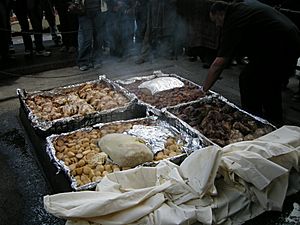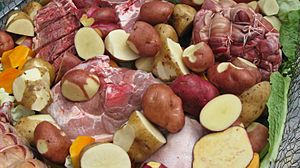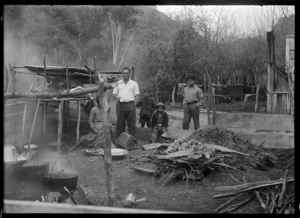Hāngi facts for kids
A Hāngi is a special way of cooking food. It comes from the Māori people in New Zealand. This cooking method uses hot rocks buried in a pit in the ground. This pit is called an umu. People still use hāngi for big groups and important events today.
Contents
How to Make a Hāngi
Making a hāngi is often called "laying a hāngi" or "putting down a hāngi." It involves several steps. People who are very good at making hāngi often pass their skills down through their families.
Preparing the Pit and Rocks
First, you need to dig a pit in the ground. This pit is usually about 50 to 100 centimeters (20 to 40 inches) deep. It needs to be big enough for the rocks and two layers of food baskets.
Next, you build a large fire in the pit. Logs, often from mānuka or kānuka trees, are stacked over the pit. Rocks, like andesite or basalt, are placed on top of the logs. The fire burns for about 3 to 4 hours. This heats the rocks to a very high temperature, around 600 to 700 degrees Celsius (1100 to 1300 degrees Fahrenheit). Once the fire has burned down, the hot ashes and embers are carefully removed.
Getting the Food Ready
While the rocks are heating, the food is prepared. It is placed into special wire baskets. These baskets are often lined with large leaves, like puka, banana, or cabbage leaves. Sometimes, aluminum foil is used instead.
Common foods cooked in a hāngi include different meats. You might find lamb, pork, chicken, and seafood (called kaimoana). Many vegetables are also cooked. These include potatoes, kūmara (sweet potato), yams (oca), pumpkin, squash, taro, and cabbage.
Cooking and Serving
Once the rocks are hot and the food is ready, the meat basket goes into the bottom of the pit. The vegetable basket is placed right on top of it. Wet sacks or thick cloths are then laid over the baskets. Finally, the entire pit is covered with earth.
The food cooks slowly for about 2.5 to 4 hours. Someone usually watches the hāngi while it cooks. If any steam escapes, they cover it with more earth to keep the heat in.
When the hāngi is cooked, the earth is carefully removed from the top. Then, the wet sacks or cloths are taken off. The baskets are lifted out of the pit. The delicious food is then taken to the kitchen to be carved and served.
Hāngi Through History
Old Ways of Cooking
Long ago, before people in New Zealand used metal, food was placed between bark and large leaves. These natural materials also served as the covering for the pit. Wire baskets became popular in the early 1800s. Wet sacks and cloth then replaced leaves and bark as the preferred covering.
Early Polynesian settlers in New Zealand used large cooking pits called umu. These were designed to cook tī kōuka (cabbage tree) roots. These special pits, called umu-ti, were much bigger than regular earth ovens. The long, carrot-shaped roots were cooked in these stone-lined pits for one to two days. This made a sweet, soft pulp. This cooking method was also common in places like the Cook Islands.
Modern Hāngi
Today, some people use modern "hāngi machines." These machines are made of stainless steel and are heated by gas. They cook food in a similar way to a traditional hāngi. However, they don't need a wood fire, hot rocks, or a pit dug in the ground.
See also
 In Spanish: Hāngi para niños
In Spanish: Hāngi para niños





